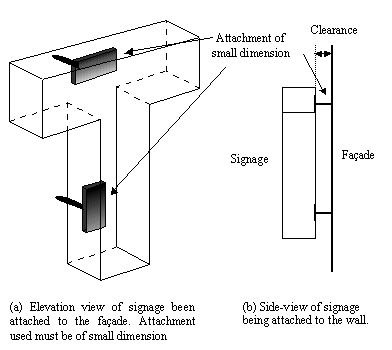Case 4
- Introduction
- Causes of Defects
- Good Practices
- Standards
- Maintenance and Diagnostics
- Remedial
- Similar Cases
- References
Good Practices

- Protruding fixtures such as signage and external electrical installations are common protrusions that may cause staining to facades. Instead of fixing the letterings and signage tightly to the wall, they may be fixed by means of small-dimensioned bolts with clearance allowed between the façade and the fixture (Figure 3). In this way, disruption of runoff flow would be significantly minimised. The attachment points would also gather minimal dirt.
- By comparison of the two methods of attaching fixtures to the façade, it is evident that by allowing a clearance between the façade and the fixture, runoff flow would be able to flow undisturbed and staining below the protrusion would be minimized. When selecting the material of attachment, more attention should be paid to its durability. Some contractor teams may overlook such consideration. In consequence, staining may be a result of the attachment material corroding, rather than due to dirt accumulation and redisposition.
- Staining can be minimised or even prevented with good design, installation and maintenance considerations. Designs can be kept simple and provisions allowed for controlled flow of rainwater runoff or to throw water off the facade. Workmanship on-site should be ensured so that good designs are properly executed. A maintenance schedule could be worked out so that the facade is cleaned periodically with cleaning agents recommended by the facade manufacturer.
Design
Specify material and application methods for water repellence of porous masonry in accordance with BS 8221-2, SS 509-2 or equivalent. Throw off water from the façade altogether through an outward projecting sill or overhanging eaves (which incorporate a throat or drip lines on its underside) or provide blocking features such as copings/flashings. Use efficient scupper drains/downpipes to channel water down and away from the façade. To provide drip grooves along the underside of projecting features. Specify a paint system, which is permeable to avoid any paint defects which may cause staining.
Render the detailing for open joints as opposed to butt joints to avoid sealant staining. To use nonbleed sealants so as to prevent staining from silicone oil. Recommend joint designs, which are able to retain rainwater runoff within joints and expansion joints designated to provide vertical runoff carrying dirt down along the façade surface. Specify façade self-cleaning applications (e.g., TiO2, superhydrophobic
paint products, etc.) with due consideration given to site orientation, sunshades and protruding features. To understand the impacts of environmental, material, design and maintenance aspects on rainwater runoff.
See also Staining of Facades
Construction
Paint façade surfaces evenly with no patchiness. The finished texture should be uniform in colour. Ensure proper rendering to control surface granularity and local faults as it influences colour uniformity of the external façade in accordance with ISO 7361 or equivalent. Correct sealant applications to ensure consistent and continuous quality. Avoid misaligned panels of cladding in accordance with BS 8000-0 or equivalent. Refer to the planning of the painting programme, including inspection regime (initial and routine inspections) for buildings in accordance with BS 6150, SS 542 or equivalent.
Use self-cleaning coatings on newly built substrates for increased success in its performance. All construction/repair works on a façade surface should be done prior to application of a water repellent in accordance with BS 8221-2, SS 509-2 or equivalent. For serviceability of exterior façade surfaces, adopt ASTM E1667-95a or equivalent. It is important as it dictates the building’s individual and corporate identity. The correct application of TiO2 coating is crucial to ensure proper adhesion to the substrate. It is also challenging to check the proper application of the coating, especially on high-rise buildings, due to
its transparent property.